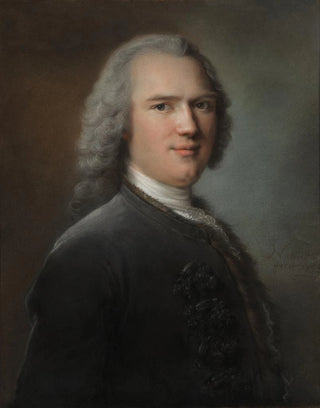Art print | Portrait of an Unknown Gentleman - Jean-Marc Nattier


View from behind

Frame (optional)
Art print Portrait of an Unknown Gentleman - Jean-Marc Nattier – Captivating Introduction
The "Portrait of an Unknown Gentleman" by Jean-Marc Nattier is a work that awakens curiosity and prompts questions. This painting, emblematic of the 18th century, immerses us in an era where portraiture held particular significance, not only as an art form but also as a reflection of societal morals and values. The depicted character, whose identity remains a mystery, invites the viewer to ponder his story, status, and role within his time. This piece, through its elegance and depth, transcends mere portraiture to become a symbol of a bygone era, while remaining strikingly modern.
Style and uniqueness of the work
Nattier, master of the art print, stands out for his keen eye for detail and his ability to capture the very essence of his subjects. In "Portrait of an Unknown Gentleman," the finesse of facial features, the delicacy of drapery, and the brightness of colors testify to his exceptional talent. The gentleman, dressed in a sumptuous outfit, is depicted in a pose that is both natural and majestic, giving the work an atmosphere of dignity. The interplay of light and shadow, skillfully orchestrated, adds an almost sculptural dimension to the composition. The artist manages to create an intimacy between the subject and the viewer, making the gentleman's gaze both penetrating and mysterious. It is this ability to combine technical precision with artistic sensitivity that makes this work a true masterpiece of classic portraiture.
The artist and his influence
Jean-Marc Nattier, an emblematic figure of the 18th century, is often recognized as the court portraitist of France. His work fits within a tradition where the portrait becomes a means of asserting social status and power. Nattier, through his creations, transcended the conventions of his time by infusing a touch of delicacy and sensuality into his portraits. His influence extends well beyond his era, inspiring many artists who sought to capture the complexity of the human soul through portraiture. Moving away from traditional representations,

Matte finish

View from behind

Frame (optional)
Art print Portrait of an Unknown Gentleman - Jean-Marc Nattier – Captivating Introduction
The "Portrait of an Unknown Gentleman" by Jean-Marc Nattier is a work that awakens curiosity and prompts questions. This painting, emblematic of the 18th century, immerses us in an era where portraiture held particular significance, not only as an art form but also as a reflection of societal morals and values. The depicted character, whose identity remains a mystery, invites the viewer to ponder his story, status, and role within his time. This piece, through its elegance and depth, transcends mere portraiture to become a symbol of a bygone era, while remaining strikingly modern.
Style and uniqueness of the work
Nattier, master of the art print, stands out for his keen eye for detail and his ability to capture the very essence of his subjects. In "Portrait of an Unknown Gentleman," the finesse of facial features, the delicacy of drapery, and the brightness of colors testify to his exceptional talent. The gentleman, dressed in a sumptuous outfit, is depicted in a pose that is both natural and majestic, giving the work an atmosphere of dignity. The interplay of light and shadow, skillfully orchestrated, adds an almost sculptural dimension to the composition. The artist manages to create an intimacy between the subject and the viewer, making the gentleman's gaze both penetrating and mysterious. It is this ability to combine technical precision with artistic sensitivity that makes this work a true masterpiece of classic portraiture.
The artist and his influence
Jean-Marc Nattier, an emblematic figure of the 18th century, is often recognized as the court portraitist of France. His work fits within a tradition where the portrait becomes a means of asserting social status and power. Nattier, through his creations, transcended the conventions of his time by infusing a touch of delicacy and sensuality into his portraits. His influence extends well beyond his era, inspiring many artists who sought to capture the complexity of the human soul through portraiture. Moving away from traditional representations,






